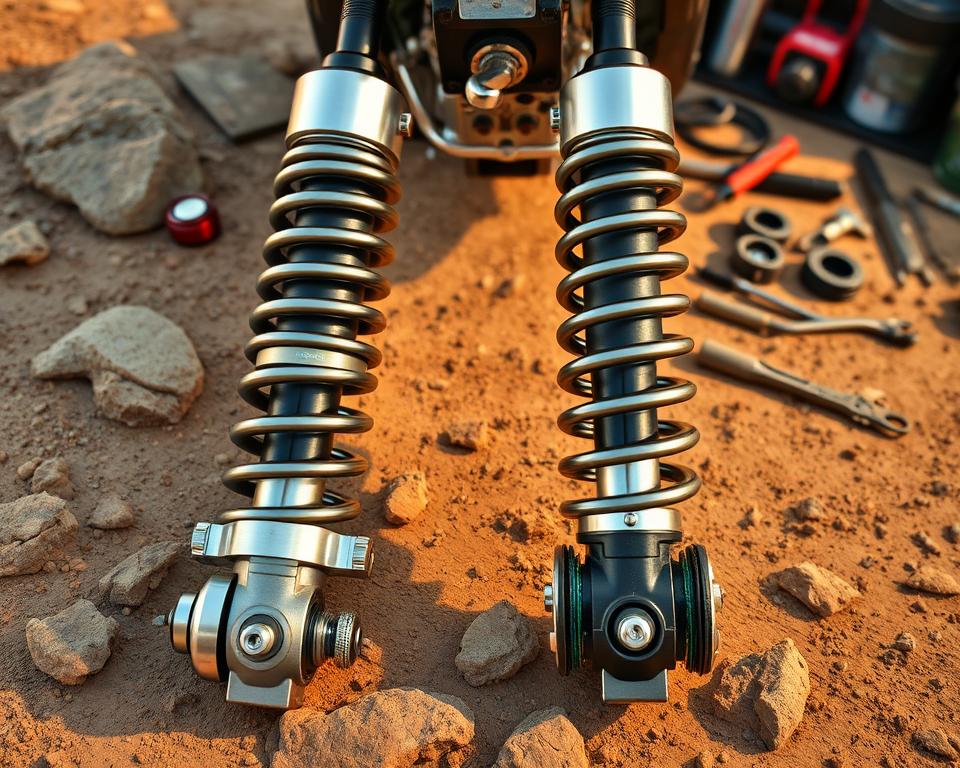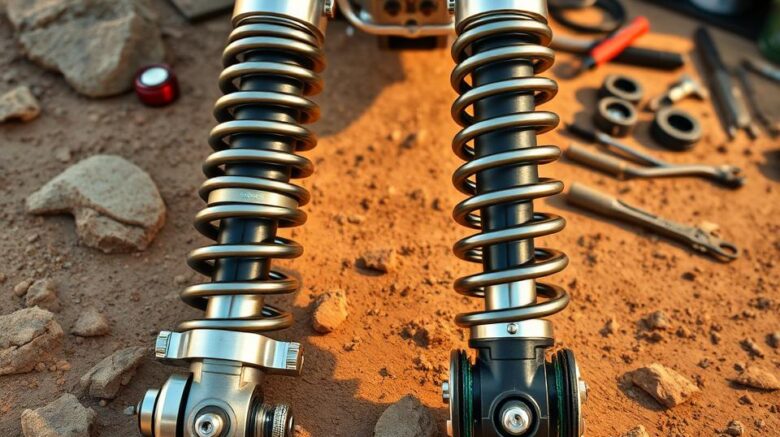Must-Have ATV Off-Road Safety Checklist
Have you heard nearly around 450,000 ATV-related injuries are treated in U.S. emergency rooms each year? Such a high number stresses the importance of being prepared and safe on the trails. Use this Essential ATV Off-Road Checklist to ensure every ride is safe and fun. It covers everything from rocky trails to sand dunes. With the right safety gear and Motohavoks tires essentials, you can minimize risks and boost your adventure.
Summary Highlights
- Start with safety: follow this checklist for full prep.
- Your gear list is critical for staying protected off-road.
- Regular maintenance is key to keep your ATV in top shape.
- Water and snacks—musts for long off-road sessions.
- Don’t wander: rely on trusty navigation tools.
- Pack layers and waterproofs for all conditions.
- Always carry essential tools and recovery kits for on-trail repairs and emergencies.
Understanding the Importance of Safety Gear
When you ride off-road, safety must come first. Riding an ATV is thrilling but comes with risks. Safety gear is essential for protecting riders from accidents and injuries. A full gear check means a safer outing.

Essential Protective Gear
Maximizing protection involves several key items:
- Helmets: Always use a DOT helmet to guard against head trauma.
- Eye Protection: Block dirt and grit with quality goggles.
- Gloves: Wear durable gloves for better grip and hand protection.
- Footwear: Ankle-support boots are a must.
- Protective Armor: Wear armor to guard your torso on rough trails.
- Neck Protection: A neck brace protects your spine in a crash.
Emergency Preparedness
Don’t overlook your emergency kit. A well-packed kit might save your life. Key items to include are:
- First aid kit
- Multi-tool
- Tire repair kits
- Portable air compressors
- Emergency blankets
- Whistles
- Matches
ATV Equipment for Optimal Performance
Proper equipment is essential for boosting your ATV’s performance on trails. Knowing the must-have ATV equipment ensures you’re ready for any journey. Regularly following an ATV maintenance checklist helps maintain your machine’s functionality and longevity.
Must-Have ATV Equipment
- Durable Tires: Invest in tires designed for various terrains to improve traction and handling.
- Storage Solutions: Keep tools and spares within reach.
- Fuel Reservoir: Opt for a robust tank to avoid drips and dry runs.
- First Aid Kit: Prepare for emergencies with a well-stocked first aid kit for immediate attention if needed.
Regular Maintenance for Longevity
Establishing a consistent maintenance routine is vital. Regular inspections should encompass:
- Checking air filters to keep the engine running smoothly.
- Lubricating the chain to ensure optimal performance.
- Inspecting brakes for safety before each ride.
Stay on top of upkeep and your ATV will perform its best.
The Essential ATV Off-Road Checklist
Preparing for a ride is more than just hopping on your ATV. A quick check prevents major headaches. Cover every item for a worry-free ride. A thorough pre-ride assessment is key to a safe outing.
Pre-Ride Inspection Basics
Never ride without a quick systems check. This quick evaluation helps riders identify and address issues before they start. Key elements to check include:
- Tire pressure and tread condition
- Fluid levels such as oil and fuel
- Brakes and controls functionality
- Operational lights and horn
- Chain or driveshaft integrity
T-CLOC Inspection Method
Use T-CLOC for a thorough pre-ride check. Five key areas: T-CLOC ensures all are inspected. This method ensures all critical areas are covered:
| Inspection Area | Checklist Items |
|---|---|
| Tires and Wheels | Check tire pressure, inspect tread depth, look for damage |
| Controls | Test brakes, throttle, and clutch for smooth operation |
| Lights | Ensure headlights, brake lights, and indicators are functioning |
| Oil and Fuel | Check oil level, inspect for leaks, and fill fuel tank |
| Chain/Driveshaft | Examine for wear, proper tension, and lubrication |
A quick T-CLOC saves you big trouble later. Keep the adventure going with no surprises.
Hydration and Nutrition for Long Rides
Don’t underestimate water and snacks on extended outings. Always carry more water than you think you’ll need. Carry extra water to prevent fatigue and keep energy levels up during the adventure. Pack high-energy bites to keep you going.
Importance of Staying Hydrated
Hydration is critical for ATV riders to stay alert and capable throughout their journey. It’s important to drink water consistently, not just when thirsty. Backpack reservoirs keep water flowing hands-free.
High-Energy Snacks to Pack
The right fuel makes the ride smoother. Opt for non-perishable items that are easy to consume. Some ideal choices include:
- Protein bars
- Nut mixes
- Dried fruits
- Beef jerky
Grab-and-go snacks let you refuel on the move. Mix sweet and salty options for flavor and function.
Navigation Tools for Off-Roading Adventures
Exploring uncharted territory demands reliable navigation tools. Off-road navigation tools are invaluable for staying on track, no matter the terrain.
Advanced GPS Systems
High-end GPS units guide you through the wild. Choose units with rugged builds, offline charts, and extended runtime. Brands like Garmin and TomTom offer models designed for off-road use, ensuring durability and precision.
Traditional Navigation Aids
Always carry a paper map along with your GPS. Maps won’t die when batteries do. Map-and-compass know-how keeps you in control. Blend modern and classic for ultimate wayfinding.
Communication Equipment for Safety
When phones fail, two-way radios deliver. Clear comms keep your group coordinated. Talking to your team prevents misadventures.
Group rides need reliable radios. Opt for radios rated for miles of reach. They allow for real-time updates on any changes or hazards. When choosing two-way radios, look for models with:
- Rugged, waterproof design to resist the elements
- Long battery life for extended trips without needing a recharge
- Multiple channels for clear communication without interference
No ride is complete without radios. Group comms save time and reduce risk. When reception is zero, your radio still works. Stay connected, stay safe.
Self-Rescue Gear for ATV Riders
Every ATV rider should be ready for unexpected situations on the trail. With the right kit, you’ll tackle obstacles solo. Being self-sufficient elevates confidence and safety.
Winches and Recovery Kits
Never ride dirty trails without a winch. Kit up your winch for maximum extraction muscle. Recovery kits usually include:
- Tow straps
- D-rings
- Recovery boards
- Gloves
Knowledge plus gear equals true self-rescue. Don’t let stuck wheels end your ride.
Trail Recovery Essentials
Pack these extras along with your winch. These include:
| Equipment | Purpose |
|---|---|
| Recovery Straps | Used for towing or pulling ATVs out of tight situations. |
| Shovel | Helps clear obstacles and dig out vehicles when stuck. |
| Traction Mats | Provides grip under tires in muddy or slick conditions. |
| Portable Air Compressor | Enables quick tire inflation after deflating for better traction. |
Don’t rely on luck—bring the right tools. Knowing how to use these tools greatly improves safety and adventure on your off-road excursions.
Staying Adaptable: Preparing for Weather Changes
Expect the unexpected in the outdoors. Be prepared for sun, rain, or wind at any moment. Don’t forget your layers and rain shell.
Layer up, shed as needed. A dry base keeps you cozy. Mid-layers trap heat and pack small. Lastly, have a waterproof and wind-resistant outer shell. Stay dry and warm through all conditions.
Weather-Appropriate Clothing
- Rain Shells: Essential for keeping dry during unexpected rain showers.
- Ventilated Off-Road Pants: Stay cool and dry with breathable pants.
- Sun Protection: Lightweight, long-sleeved shirts and wide-brimmed hats safeguard against harmful UV rays.
- Cold-Weather Gloves: Keeps hands warm and functional during colder rides.
Don’t let the weather ruin your ride. Comfortable riders ride longer and safer.
Tools for On-Trail Repairs
Your toolkit can make or break your day on the trail. Don’t skimp on repair gear. Fix flats and loose bolts in minutes.
Must-Have Tools and Kits
No ride is complete without a toolkit. Pack only the essentials—no junk. Critical ATV repair tools might include:
- Tire irons for changing flat tires
- Pliers for gripping and cutting
- Wrenches for various sizes of bolts and nuts
- A multi-tool for versatility
- Spare items such as spark plugs and electrical wire
- Duct tape for quick fixes
Having these tools readily available boosts confidence and autonomy while exploring off-road trails.
Basic Emergency Supplies
In addition to essential tools, packing basic emergency supplies for ATV is vital. These supplies help ensure your safety in challenging situations:
- First aid kit for injuries
- Flashlight with extra batteries for night-time visibility
- Emergency whistle for signaling assistance
- Reflective triangles or flares to warn other riders
- Water and high-energy snacks for sustenance
Preparation pays off big time. Always keep these ATV repair tools and emergency supplies handy.
Final Thoughts
Preparation is the secret to epic trails. Follow this checklist and choose quality gear. Ride confidently on every surface.
Gear up fully and ride securely. Effective planning is vital for both safety and performance. Focus on fun, not fears.
Be prepared, ride safe, and make great memories. Your ride’s story begins with good prep. Check this list, then conquer nature.
Frequently Asked Questions
What belongs on an ATV gear list?
Start with a DOT helmet and sturdy goggles. Add gloves, boots, and torso protection. Consider a neck brace for extra safety. Always carry a first aid pack and a multi-tool.
Tips for ATV upkeep?
Inspect air filters and grease the chain often. Don’t ignore brake checks. A consistent maintenance routine extends your machine’s life and keeps it ready for off-road adventures.
What does the T-CLOC inspection method entail?
The T-CLOC inspection method covers several key areas. Tires, Controls, Lights, Oil, and Chain are checked in T-CLOC. Using T-CLOC guarantees safe, smooth rides.
How much water should I bring on an ATV trip?
Pack extra hydration for safety. Stay topped off to avoid dehydration. Hydration packs make accessing water easy.
How to stay on course off-road?
Get a durable GPS with offline maps. Combine this with traditional aids like waterproof maps and compasses.
Why is communication important when off-roading?
Radios prevent isolation when cell fails. In no-signal zones, radios shine.
What self-rescue gear should every ATV rider carry?
Pack a winch plus full recovery gear. Include straps, shackles, and traction boards.
Tips for weather readiness off-road?
Use a base, mid, and shell layering system. Don’t get caught soaked—bring waterproofs. Sun protection is also critical to prevent UV exposure.
What tools should I pack for on-trail repairs?
Carry essential wrenches, pliers, and irons. Have spares and tape for quick fixes.
